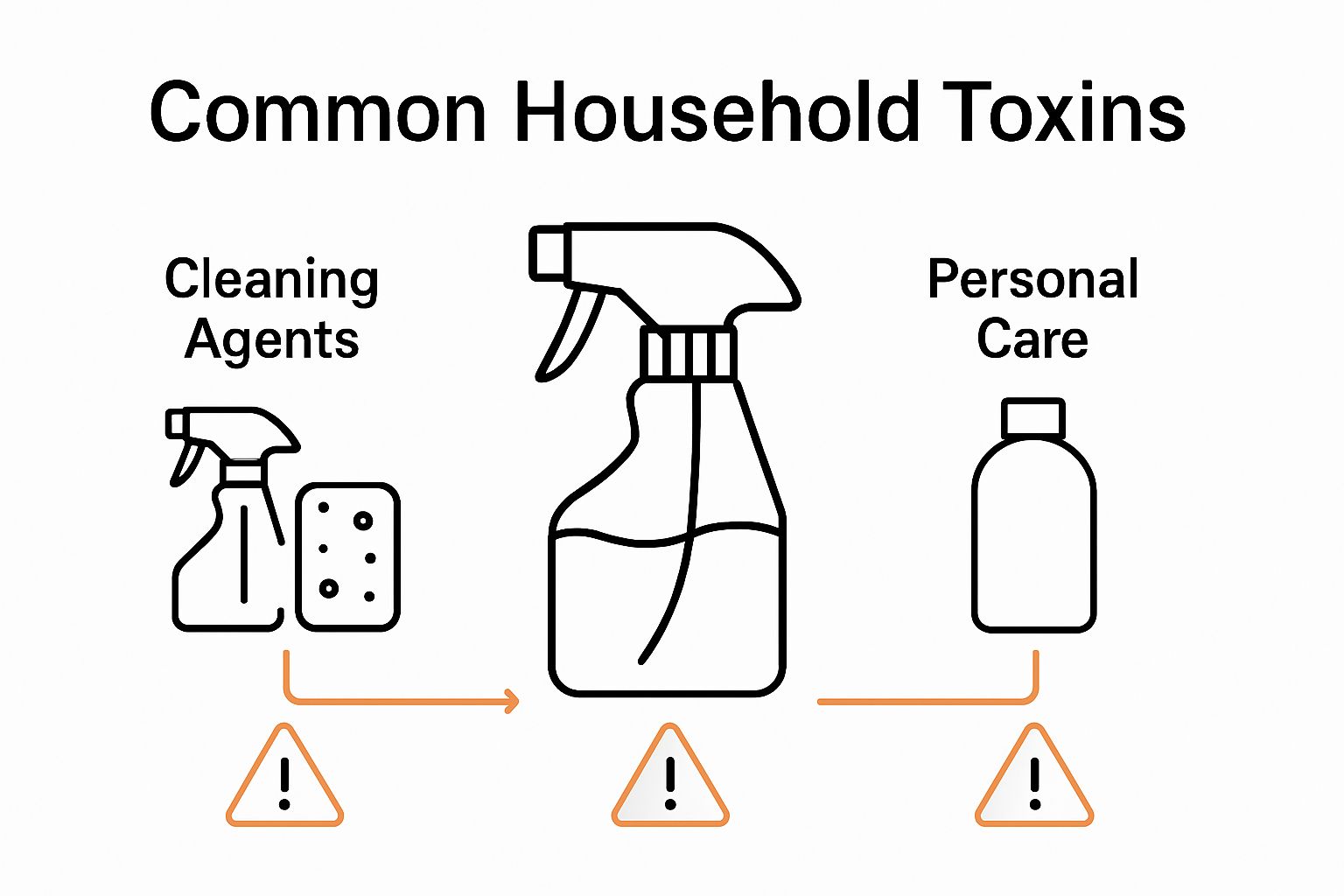Everyday products like cleaners, cosmetics, and plastics fill your home with substances you cannot see, touch, or smell. Here is something that will make you pause. The average person is exposed to dozens of potentially harmful chemicals just by spending time indoors, according to Environmental Working Group research. Most people think danger only comes from toxic spills or obvious hazards, but the real threat is silent and steady exposure that adds up in surprising ways.
Table of Contents
- What Are Common Household Toxins?
- Why Common Household Toxins Matter To Your Health
- How Common Household Toxins Affect Your Body
- Key Concepts In Identifying Toxic Substances At Home
- Real-World Implications Of Household Toxins
Quick Summary
| Takeaway | Explanation |
|---|---|
| Identify common household toxins. | Regularly check household products for harmful chemicals like parabens and phthalates. |
| Understand exposure pathways. | Chemicals can enter your body through skin contact, inhalation, ingestion, or surface contact. |
| Beware of long-term health risks. | Chronic exposure can lead to serious health issues, including reproductive problems and neurological disorders. |
| Learn to read product labels. | Familiarize yourself with warning signs and chemical names on labels to make safer choices. |
| Utilize assessment strategies. | Use safety databases and registries to identify toxic substances in your home. |
What Are Common Household Toxins?
Common household toxins are potentially harmful chemical substances found in everyday environments that can negatively impact human health. These invisible threats lurk in products we use daily, from cleaning supplies to personal care items, silently exposing our bodies to dangerous compounds that can disrupt biological processes.
Chemical Exposure in Everyday Life
Modern homes are filled with potential sources of toxic chemicals. Environmental Working Group research reveals that an average person encounters numerous toxins through seemingly innocuous household items. These substances can enter our bodies through multiple pathways:
- Skin absorption during product use
- Inhalation of chemical vapors
- Ingestion through contaminated food or water
- Direct contact with treated surfaces
Toxins do not necessarily require massive exposure to create health problems. Even small, repeated interactions can accumulate and potentially trigger long-term health complications.
The table below summarizes how common household toxins can enter the body and their associated possible health effects, assisting you in understanding critical exposure pathways highlighted in the article.
| Exposure Pathway | Description | Potential Health Effects |
|---|---|---|
| Skin Absorption | Contact during use of products | Irritation, systemic absorption |
| Inhalation | Breathing chemical vapors | Respiratory issues, neurological symptoms |
| Ingestion | Consuming contaminated food or water | Digestive problems, developmental disruption |
| Surface Contact | Touching treated objects/surfaces | Cumulative exposure, allergic reactions |
Types of Common Household Toxins
The spectrum of household toxins is broad and diverse.
 Some prevalent categories include:
Some prevalent categories include:
- Cleaning Agents: Harsh chemicals in detergents, disinfectants, and surface cleaners
- Personal Care Products: Synthetic fragrances, parabens, and petrochemicals in cosmetics
- Plastics: Bisphenol A (BPA) and phthalates in food containers and packaging
- Furniture and Building Materials: Flame retardants, formaldehyde, and volatile organic compounds (VOCs)
National Institutes of Health studies indicate these substances can act as endocrine disruptors, potentially interfering with hormonal systems and cellular communication. Understanding these toxins represents the first step in minimizing our exposure and protecting our overall health.
To help you recognize the most common household toxins, the table below organizes main categories, examples, and potential health impacts as described in the article.
| Category | Example Substances | Common Sources | Potential Health Impacts |
|---|---|---|---|
| Cleaning Agents | Ammonia, bleach | Detergents, disinfectants, cleaners | Respiratory irritation, skin contact reactions |
| Personal Care Products | Parabens, synthetic scents | Cosmetics, shampoos, lotions | Hormone disruption, allergic responses |
| Plastics | BPA, phthalates | Food containers, plastic packaging | Endocrine disruption, reproductive problems |
| Furniture and Building Materials | Flame retardants, formaldehyde, VOCs | Upholstery, flooring, pressed wood | Respiratory issues, long-term toxicity |
Why Common Household Toxins Matter to Your Health
Toxins in our everyday environment represent more than just abstract health risks. They are silent invaders that can profoundly impact our biological systems, potentially disrupting cellular function and long-term wellness in ways many people do not fully comprehend.
The Biological Impact of Toxic Exposure
Harvard Medical School research demonstrates that chronic exposure to household toxins can trigger significant cellular damage. These substances interact with our body’s intricate systems, potentially causing inflammation, oxidative stress, and genetic alterations that compromise overall health.
The human body processes these chemical compounds through complex metabolic pathways. While our natural detoxification systems work continuously to eliminate harmful substances, prolonged or intense exposure can overwhelm these protective mechanisms. Key biological responses to toxic exposure include:
- Disruption of hormonal signaling
- Mitochondrial dysfunction
- Cellular membrane damage
- Immune system suppression
Long Term Health Consequences
Environmental Protection Agency studies reveal that repeated interactions with common household toxins can contribute to serious health conditions. These are not immediate reactions but gradual, cumulative processes that develop over years of consistent exposure.
Potential long-term health risks associated with chronic toxic exposure include neurological disorders, reproductive challenges, metabolic disruptions, and increased cancer risks. Vulnerable populations such as children, elderly individuals, and those with compromised immune systems face heightened susceptibility to these environmental challenges.

Understanding these risks empowers individuals to make informed choices about their living environments, personal care products, and overall lifestyle strategies that minimize toxic interactions.
How Common Household Toxins Affect Your Body
The human body interacts with toxic substances through complex biochemical mechanisms that can trigger profound systemic responses.
When exposed to these environmental chemicals, our biological systems undergo intricate changes that might not be immediately visible but can significantly impact long-term health.
Cellular Disruption Mechanisms
National Institute of Environmental Health Sciences research reveals that household toxins can penetrate cellular membranes, disrupting fundamental biological processes. These substances interfere with critical cellular functions by mimicking or blocking natural hormones, creating significant metabolic disturbances.
Specific cellular disruption pathways include:
- Mitochondrial energy production interference
- Genetic expression alteration
- Oxidative stress generation
- Protein structure modification
The body’s intricate defense mechanisms attempt to neutralize these toxic compounds, but continuous exposure can overwhelm natural detoxification systems. Learn more about protection strategies in our guide on EMF-producing devices.
Systemic Health Implications
Toxic exposure triggers cascading effects throughout bodily systems. Endocrine disruption can lead to hormonal imbalances affecting metabolism, reproductive health, and neurological functioning. The immune system becomes compromised, reducing its ability to combat infections and potentially increasing susceptibility to chronic inflammatory conditions.
Neurological systems are particularly vulnerable. Certain toxins can cross the blood-brain barrier, potentially contributing to cognitive decline, memory issues, and neuroinflammatory responses. Reproductive systems may experience decreased fertility, hormonal irregularities, and developmental challenges in future generations.
Key Concepts in Identifying Toxic Substances at Home
Identifying household toxins requires a strategic approach that combines scientific understanding, keen observation, and proactive research. Recognizing potential chemical hazards involves more than casual awareness it demands a systematic method of evaluation and interpretation.
Chemical Composition and Labeling
Environmental Protection Agency guidelines emphasize the critical importance of understanding product labels and chemical compositions. Toxic substances often reveal themselves through specific indicator terms and ingredient lists that conscientious consumers can learn to decode.
Warning Signs on Product Labels:
- Presence of words like “caution,” “warning,” or “danger”
- Chemical names ending in “-ene,” “-ite,” or “-ate”
- Symbols indicating potential health hazards
- Unspecified “fragrance” listings
Complex chemical names can obscure potentially harmful ingredients. Consumers must develop a nuanced understanding of ingredient terminology to make informed decisions about household products.
Detection and Assessment Strategies
National Institutes of Health toxicology research suggests multiple approaches for identifying potential toxic substances. Key assessment strategies include:
- Utilizing scientific databases and chemical registries
- Consulting product safety databases
- Understanding material safety data sheets
- Learning about electromagnetic radiation sources that might contribute to environmental toxicity
Contextual awareness is crucial. Not all chemicals are inherently dangerous some pose risks only under specific concentrations or exposure conditions. Developing a nuanced understanding of toxic substances requires ongoing education and critical analysis of scientific information.
Real-World Implications of Household Toxins
The pervasive presence of toxic substances extends far beyond theoretical health risks. Real-world consequences manifest through complex interactions between environmental chemicals and human biological systems, creating tangible impacts across multiple generations and societal domains.
Health and Developmental Consequences
Environmental Health Perspectives research demonstrates alarming connections between indoor toxic exposures and significant health challenges. Children represent the most vulnerable population, experiencing profound developmental disruptions from prolonged chemical interactions.
Critical developmental risks include:
- Increased childhood asthma rates
- Neurological developmental disorders
- Compromised immune system functioning
- Potential epigenetic modifications
These toxins do not simply affect individual health but potentially reshape genetic inheritance patterns, creating multigenerational health implications that extend beyond immediate exposure.
Societal and Economic Impact
Toxic exposures generate substantial economic burdens through escalating healthcare costs and reduced workforce productivity. Chronic health conditions emerging from environmental chemical interactions necessitate complex medical interventions and long-term treatment strategies.
Learn about electromagnetic radiation protection strategies that complement broader toxin mitigation efforts. Understanding these interconnected environmental challenges allows individuals to make more informed lifestyle choices that minimize potential health risks.
Take Control of Hidden Household Threats with Proven EMF Protection
Are you worried about the invisible toxins that disrupt your body’s health every day? The article has shown how ordinary electronics and home devices can overload your natural defenses, leading to cellular stress, hormone imbalances, and long-term risk. Many people feel powerless against these dangers, especially as science reveals just how deeply household toxins and electromagnetic field (EMF) radiation can harm your energy, focus, and well-being. You do not have to accept this as your reality.

Choose a safer home environment today. Discover how Omnia Radiation Balancer products are backed by testing on the heart, blood, and cellular strength to show real protection from EMF exposure. Want to know which common devices are affecting your body the most? See the list of EMF-producing devices you can protect against and get started with proven solutions. Visit omniaradiationbalancer.com now and take your first step towards measurable wellness for you and your loved ones.
Frequently Asked Questions
What are common household toxins?
Common household toxins are harmful chemical substances found in everyday products such as cleaning supplies, personal care items, plastics, and building materials. They can enter our bodies through skin absorption, inhalation, ingestion, or direct contact.
How can household toxins affect my health?
Household toxins can disrupt biological processes and lead to long-term health complications. Potential effects include hormonal imbalances, neurological disorders, reproductive challenges, and increased cancer risks due to chronic exposure.
What are some common types of household toxins I should be aware of?
Common types of household toxins include harsh chemicals in cleaning agents, synthetic fragrances and parabens in personal care products, BPA and phthalates in plastics, as well as flame retardants and formaldehyde in furniture and building materials.
How can I identify toxic substances in my home?
You can identify toxic substances in your home by examining product labels for warning signs such as the presence of words like “caution,” “warning,” or “danger,” as well as understanding chemical names and terms commonly associated with toxicity.
Recommended
- Common EMF-Producing Devices: Understanding EMF Sources – Omnia Radiation Balancer
- The Top 3 Radiation-emitting Devices in Your Home – Omnia Radiation Balancer
- EMF Protection for Kids - Omnia Radiation Balancer
- How Does EMF Radiation Exposure Affect Our Skin? – Omnia Radiation Balancer
- Understanding DIY Pest Control Safety For Homeowners – Pestico: Pest Control Services Near Me | Van Alstyne, TX



Share and get 15% off!
Simply share this product on one of the following social networks and you will unlock 15% off!